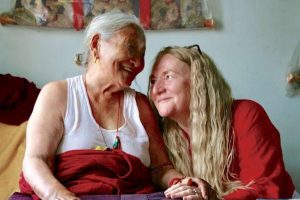I almost never woke up to the five o’clock gong—the first gong of the day in a life, if not ruled by the gong, then certainly regulated by it. I didn’t have to pay attention to most of the gongs, only the mealtime ones and those that marked my English classes. Sometimes, what woke me was a strange sound like the drone of bees, which turned out to be the chanting of the nuns doing their individual practice, the sound reverberating around the concrete walls. Sometimes it was their morning practice in the temple at six, sometimes, their chatting and laughter on the way to breakfast at seven . . . .
I was teaching English at the Sakya College for Nuns, 20 kilometers outside Dehradun, in Northern India, for eight months. Theirs is an unusual life, strict and restricted, to enable them to fully focus on their study of Buddhist philosophy. It is a traditional Tibetan shedra, and it takes 10 years to complete the basic degree. This is the first time the nuns are receiving this education. What’s more, there are still only a handful of these colleges for nuns. This is part of what drew me there, to support them in this endeavor with the only means available to me: the English language. These nuns are really breaking new ground, especially the first group in, who were then in their fifth year of study. This is not how they see themselves. They are just there to study and learn Buddhist philosophy, and are happy to have the opportunity. They are so eager to learn, and this made them easy to teach. Somewhat.
One of the difficulties in teaching the nuns was their shyness. Another was the formality. There is incredible respect for teachers, and the shedra setting is very formal. I set to, to break down the formality a little bit, though not too much. And also to work around the shyness and draw them out a little bit. I hoped that they would have some fun, in their incredibly intense days of study, and also learn more English. Especially in the Level 1 Class, which was bigger. Here, as some of them knew virtually no English, I never called on them individually, only in small groups. They are used to learning by rote, and that is also what we did. Some days they just took it over, read the sentence, re-read the sentence again and again, without me saying anything. As I looked down at all the faces in the room, I would feel an intense joy and satisfaction and privilege at being there.
Most of the nuns are from rural areas in Tibet, Nepal, and across the Himalayan region. They have left their homes to become nuns, one of the reasons being that this is the only way for them to get any education. They each have their own story. So many of them touched my heart. There was one who, at the end, I was calling my star pupil. She had had English classes before, but couldn’t seem to learn the language. I really wanted her to. Then one day she told me that she had grown up herding animals and had not learned her ka kha ga nga [the Tibetan alphabet] until she was 20. Now here she was, learning Tibetan Buddhist philosophy, one of the most difficult things to study and understand. I was so amazed and inspired. Towards the end she started picking up the English words, and another nun told me she was now “famous” for speaking English, using the English words she knew as often as possible.
The nuns start their day with an optional study hour at five o’clock. From eight until twelve, there are teachings from the Khenpo (philosophy teacher) and further self-study. They keep silence throughout the morning, with only the gong marking the change of classes. Then, from half three until half eight, the nuns debate. The sound would carry from the courtyard to my room on the second floor. I loved both hearing and watching them debate. Some of the shyest, quietest ones become quite ferocious. As they debate the topic they have studied in class that morning, they have no thought for anything else. It was hard to believe that some could barely speak in my class, from shyness.




In the afternoon tea break, I had my tea with the nuns who slept in the rooms next to mine. Mostly, this was my only social contact during the day. We drank tea, spoke a little English, spoke a little Tibetan, sometimes serious, sometimes laughing.
Living there was like living in a warm embrace. The nuns and staff were so welcoming and inclusive. Not just to me—they were like this to anyone who came to visit. It was so inspiring to live in a true, genuine and dedicated spiritual community, seemingly with no bickering and where everyone took care of each other. I feel that these nuns combine all the qualities of the Dharma, with their good-heartedness and humility now being enhanced with the wisdom and knowledge that comes from studying philosophy at such a deep level.
Now that I have left I really miss that, and find what often seems to be fake spirituality jarring. I miss the sound of robes and nuns’ laughter outside my door. I do not miss the gongs, the food, and limited hot water. And I really miss being called “Ghen-la.”Fiona White is a freelance writer, Buddhist, and carver of Mani stones, who divides her time between Ireland and India.











